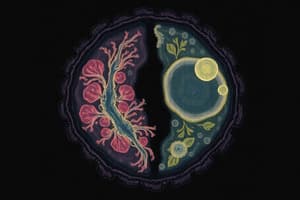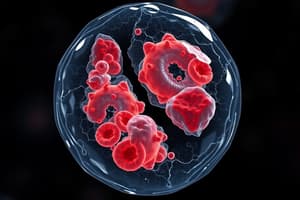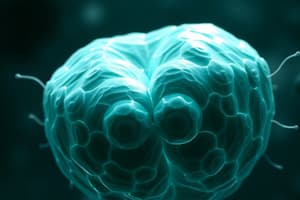Podcast
Questions and Answers
What process follows nuclear division in cell division?
What process follows nuclear division in cell division?
- Interphase
- Karyokinesis
- Metaphase
- Cytokinesis (correct)
Which phases make up interphase?
Which phases make up interphase?
- Prophase, Metaphase, and Anaphase
- Mitosis, Cytokinesis, and G1
- Telophase, Cytokinesis, and G0
- G1, S, and G2 phases (correct)
What occurs when the surface to volume ratio is small?
What occurs when the surface to volume ratio is small?
- Cellular metabolism increases
- Cell division is enhanced
- Mitosis is initiated
- Cell growth becomes inefficient (correct)
When does interphase begin in the cell cycle?
When does interphase begin in the cell cycle?
What is the role of the spindle apparatus during cell division?
What is the role of the spindle apparatus during cell division?
What is the primary outcome of meiosis?
What is the primary outcome of meiosis?
During which stage of meiosis does crossing over occur?
During which stage of meiosis does crossing over occur?
What occurs in meiosis II?
What occurs in meiosis II?
Which statement about genetic variation from meiosis is incorrect?
Which statement about genetic variation from meiosis is incorrect?
What is the significance of the nuclear envelope during metaphase?
What is the significance of the nuclear envelope during metaphase?
During which phase of mitosis do chromosomes line up at the cell's equator?
During which phase of mitosis do chromosomes line up at the cell's equator?
What occurs during anaphase in mitosis?
What occurs during anaphase in mitosis?
What is the result of mitosis in terms of chromosome number in each daughter cell?
What is the result of mitosis in terms of chromosome number in each daughter cell?
What marks the transition from metaphase to anaphase during mitosis?
What marks the transition from metaphase to anaphase during mitosis?
In which phase does chromatin decondense back into its relaxed form?
In which phase does chromatin decondense back into its relaxed form?
What happens during the G1 phase of the cell cycle?
What happens during the G1 phase of the cell cycle?
Which phase is characterized by the replication of DNA?
Which phase is characterized by the replication of DNA?
What is the function of centrioles in animal cells?
What is the function of centrioles in animal cells?
What limits how large animal cells can grow?
What limits how large animal cells can grow?
How do microtubule inhibitors function as anti-tumor drugs?
How do microtubule inhibitors function as anti-tumor drugs?
Flashcards
Cell Division
Cell Division
The process of duplication of the cell that includes karyokinesis (nuclear division) and cytokinesis (cytoplasmic division).
The Cell Cycle
The Cell Cycle
The complete process of a cell's life, from birth to division.
Interphase
Interphase
The preparatory phase for mitosis, where the cell grows, replicates its DNA, and prepares for cell division.
Surface to Volume Ratio (S/V)
Surface to Volume Ratio (S/V)
Signup and view all the flashcards
The Spindle Apparatus
The Spindle Apparatus
Signup and view all the flashcards
Mitotic phase
Mitotic phase
Signup and view all the flashcards
Centrioles
Centrioles
Signup and view all the flashcards
Metaphase
Metaphase
Signup and view all the flashcards
Anaphase
Anaphase
Signup and view all the flashcards
Telophase and cytokinesis
Telophase and cytokinesis
Signup and view all the flashcards
Crossing Over
Crossing Over
Signup and view all the flashcards
Meiosis I
Meiosis I
Signup and view all the flashcards
Meiosis II
Meiosis II
Signup and view all the flashcards
Genetic Recombination
Genetic Recombination
Signup and view all the flashcards
Centrosomes
Centrosomes
Signup and view all the flashcards
G1 Phase
G1 Phase
Signup and view all the flashcards
S Phase
S Phase
Signup and view all the flashcards
Study Notes
Cell Division
- Cell division is the process of a cell dividing into two new daughter cells
- It involves karyokinesis (nuclear division) followed by cytokinesis (cytoplasmic division)
- Diploid cells have two copies of each chromosome, forming homologous pairs
- Humans have 46 chromosomes (23 pairs)
- Centrosomes contain centrioles that produce spindle fibers for separating sister chromatids.
The Cell Cycle
- The cell cycle includes interphase (G1, S, G2) and the mitotic phase (mitosis + cytokinesis)
- Interphase follows mitosis and cytokinesis, where cells grow and replicate to enter the interphase stage
- G1: Cell growth, protein production, ribosome and mitochondria replication, and organelle replication
- S: DNA synthesis (DNA replication, creating sister chromatids); this occurs during the synthesis phase, not mitosis
- G2: Continued cell growth, preparation of genetic material for division, and replication of some organelles
- G0: Inactive state for cells not actively growing or dividing (e.g., nerve or cardiac cells)
- Surface-to-Volume ratio is important; as cells increase in size, the ratio gets smaller and cellular exchange is harder, potentially leading to division to increase surface area
- Genome-to-Volume ratio is also crucial. As the cell gets too large, it may exceed its genome's ability to produce necessary proteins for regulating cell activities.
Mitosis
- Prophase: Nucleus disassembles, nucleolus disappears, chromatin condenses into chromosomes, and spindle fibers form
- Metaphase: Chromosomes line up, each consisting of sister chromatids. Kinetochores attach to microtubules.
- Anaphase: Microtubules shorten, pulling apart sister chromatids into separate chromosomes (disjunction) towards opposite poles. Chromosomes double.
- Telophase and cytokinesis: Nuclear envelope reforms, chromosomes decondense, nucleoli reappear. This results in 2 diploid cells (with 46 chromosomes each) after division.
Meiosis
- Meiosis produces four non-identical haploid cells from one diploid parent cell. It involves two nuclear divisions (meiosis 1 and meiosis 2).
- Prophase I: Spindle forms, homologous chromosomes synapse forming tetrads, allowing crossing over to happen. Microtubules attach to chromosomes at kinetochores.
- Metaphase I: Homologous chromosomes arranged randomly at the metaphase plate (independent assortment).
- Anaphase I: Homologous chromosomes separate, directed by spindle fibers to opposite poles
- Telophase I and cytokinesis: Homologous chromosomes separate; results in two haploid (23 chromosomes) daughter cells.
- Prophase II-Telophase II: Similar to mitosis, with sister chromatids separating. Cytokinesis again produces 4 haploid cells.
Sources of Genetic Variation
- Crossing over (non-sister chromatids exchange genetic material during prophase I)
- Independent assortment (random orientation of homologous chromosomes in metaphase I)
- Random joining of gametes (which sperm fertilizes which egg)
Comparing Meiosis and Mitosis
| Feature | Meiosis | Mitosis |
|---|---|---|
| Chromosome # | Reduced by half (from 46 to 23) | Remains the same (46) |
| Daughter cells | 4 haploid cells | 2 diploid cells |
| Genetic makeup | Genetically diverse | Genetically identical |
| Cell division | 2 rounds | 1 round |
| Genetic info | Sister chromatids separate in anaphase II, homologous chromosomes separate in anaphase I | Sister chromatids separate in anaphase |
Studying That Suits You
Use AI to generate personalized quizzes and flashcards to suit your learning preferences.




